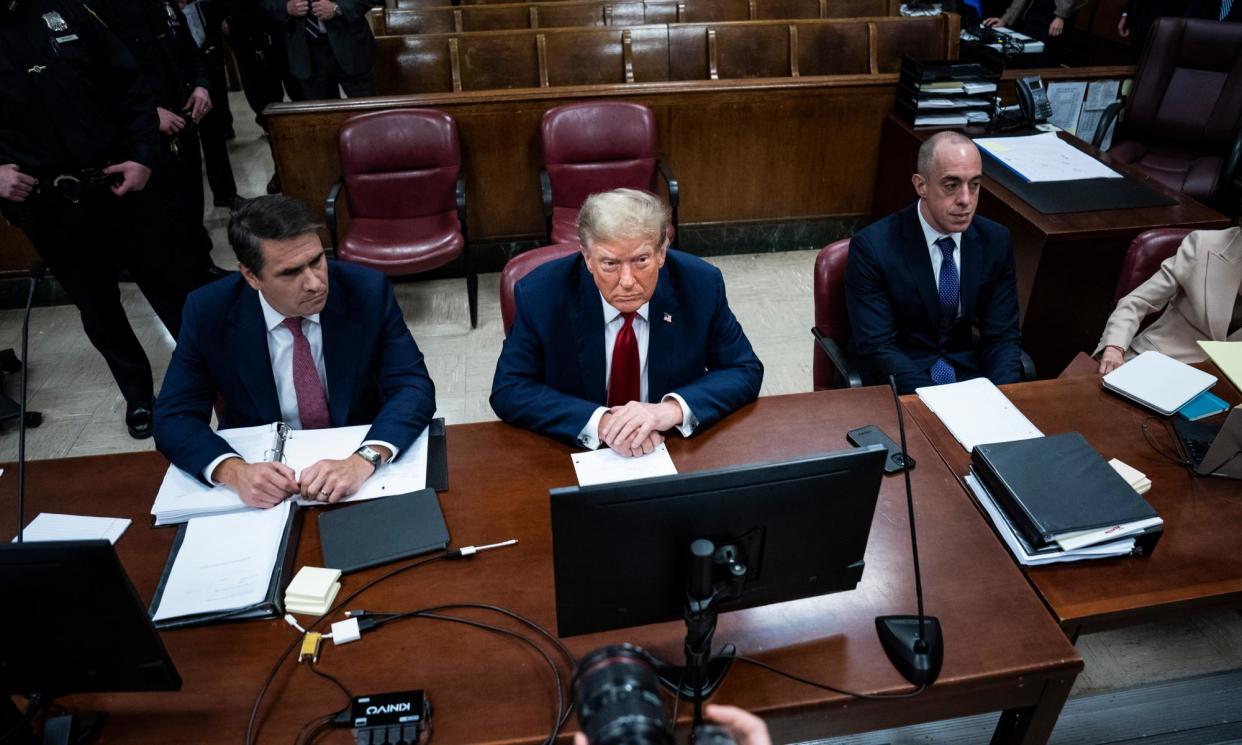Trump’s hush-money trial: key takeaways from the first day

- Oops!Something went wrong.Please try again later.
Donald Trump struggled through the opening day of his New York criminal trial on Monday as the jury selection process formally got under way in Manhattan in the first criminal trial of a current or former US president.
Trump has pleaded not guilty to 34 counts of falsifying business records in trying to cover up hush-money payments to an adult film star that influenced the 2016 election.
Trump himself did little during his time in the courtroom of the New York supreme court judge Juan Merchan. But the eventual proceeding showed the momentous nature of the case and highlighted Trump’s divisiveness.
Here are the takeaways of day one of “People v Donald Trump”:
Seating jury could take weeks
Legal experts widely expected that seating a jury in the Trump case – 12 jurors and six alternates – was going to be a difficult and lengthy process as Trump’s lawyers and prosecutors in the Manhattan district attorney’s office.
But moving through the first 100 or so potential jurors showed just how tricky the “voir dire” process could be: more than half of the group told the judge they could not be impartial and were excused immediately.
The voir dire process involves each potential juror reading their responses to a 42-point questionnaire and the judge reading out to the jurors the people who might serve as witnesses or otherwise come up at trial.
The potential jurors’ reactions toward Trump were varied. One man smiled when he saw Trump. Another woman giggled and put her hand over her mouth, looking at the person seated next to her with raised eyebrows. And one of the potential jurors, who was excused, said leaving the courtroom: “I just couldn’t do it.”
Trump’s lawyers are looking for a so-called “holdout juror” who could be partial to Trump and not convict on any of the counts – and thereby hang the jury for a mistrial.
The process also appeared to tire out Trump. Before the jury selection began in the afternoon, Trump often appeared to nod off.
Trump was stuck with judge despite delay tactics
Trump tried one more time before jury selection began to have the judge recuse himself from presiding in the case, claiming Merchan had conflicts of interest and had shown indications of bias that meant he could not be fair.
The judge addressed two of Trump’s main complaints – and dismissed them summarily.
In the first instance, the judge rejected Trump’s complaints about an interview he did with the Associated Press because he did not talk about Trump’s case, meaning the judge’s statements did not “reasonably or logically” reflect bias.
And in the second instance, the judge said a podcast interview his daughter did in 2019, in which he said he disliked politicians using Twitter, similarly did not reflect bias against any party.
Prosecutors score two additional wins
The Manhattan district attorney, Alvin Bragg, had some partial wins on Monday morning, after Merchan allowed them to admit into evidence materials that would bolster their case that Trump’s falsification of records was to influence the 2016 election.
The judge had previously ruled that prosecutors could not use as evidence the actual tape of Trump’s infamous Access Hollywood tape, as well as a video of Trump referencing the Access Hollywood tape in a deposition in an unrelated case.
But Merchan allowed prosecutors to admit into evidence the full transcript of the Access Hollywood tape, which means the infamous Trump quote that he could assault women and “grab them by the pussy” can be read to the jury at trial.
The judge also allowed prosecutors to use an email chain in which the former Trump aide Hope Hicks forwarded the transcript to another former Trump aide, Kellyanne Conway, asking if the tape was Trump’s voice. Conway then asked the ex-Trump lawyer Michael Cohen who was doing damage control.
Trump could yet be held in contempt
Trump left the courtroom after the first day of his criminal trial with another cloud hanging over his head: whether he will be found in contempt for violating a gag order that prohibited from assailing potential trial witnesses.
The former president was recently hit with an expanded gag order after he went after the judge’s daughter, alleging that her work doing campaign work for Democratic political candidates meant the judge was conflicted.
But prosecutors asked Merchan to impose a $3,000 fine on Trump for attacking two potential trial witnesses – Stormy Daniels, the adult film star at the centre of the criminal case, and his ex-lawyer Cohen – and warning him that future violations could result in jail.
The matter was scheduled for arguments at a 23 April hearing. Merchan promised to address the alleged gag order violations but said he did not want to get into it on Monday because they had several hundred potential jurors waiting.

